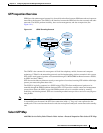
14-13
Cisco ASA Series Firewall ASDM Configuration Guide
Chapter 14 Configuring Inspection for Management Application Protocols
RSH Inspection
Fields
• Name—Shows the name of the previously configured RADIUS accounting map.
• Description—Enter the description of the RADIUS accounting map, up to 200 characters in length.
• Host Parameters—Lets you configure host parameters.
–
Host IP Address—Specify the IP address of the host that is sending the RADIUS messages.
–
Key: (optional)—Specify the key.
• Add—Adds the host entry to the Host table.
• Delete—Deletes the host entry from the Host table.
RADIUS Inspect Map Other
The RADIUS Inspect Map Other Parameters pane lets you configure additional parameter settings for
the inspect map.
Fields
• Name—Shows the name of the previously configured RADIUS accounting map.
• Description—Enter the description of the RADIUS accounting map, up to 200 characters in length.
• Other Parameters—Lets you configure additional parameters.
–
Send response to the originator of the RADIUS message—Sends a message back to the host
from which the RADIUS message was sent.
–
Enforce timeout—Enables the timeout for users.
Users Timeout—Timeout for the users in the database (hh:mm:ss).
–
Enable detection of GPRS accounting—Enables detection of GPRS accounting. This option is
only available when GTP/GPRS license is enabled.
–
Validate Attribute—Attribute information.
Attribute Number—Specify the attribute number to validate when an Accounting Start is
received.
Add—Adds the entry to the Attribute table.
Delete—Deletes the entry from the Attribute table.
RSH Inspection
RSH inspection is enabled by default. The RSH protocol uses a TCP connection from the RSH client to
the RSH server on TCP port 514. The client and server negotiate the TCP port number where the client
listens for the STDERR output stream. RSH inspection supports NAT of the negotiated port number if
necessary.
SNMP Inspection
This section describes the IM inspection engine. This section includes the following topics:
• SNMP Inspection Overview, page 14-14


















